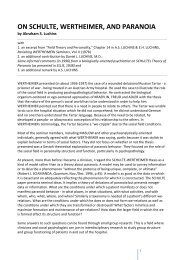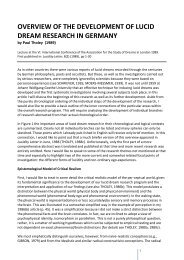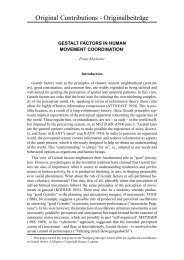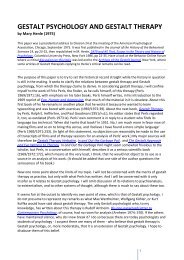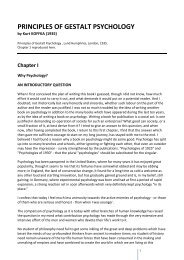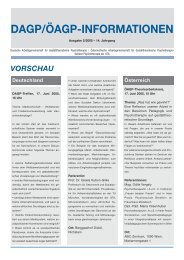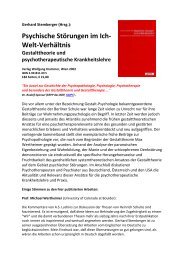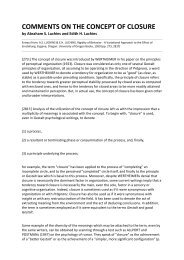pdf-Download - Society for Gestalt Theory and its Applications (GTA)
pdf-Download - Society for Gestalt Theory and its Applications (GTA)
pdf-Download - Society for Gestalt Theory and its Applications (GTA)
You also want an ePaper? Increase the reach of your titles
YUMPU automatically turns print PDFs into web optimized ePapers that Google loves.
dimensional; it takes place in space <strong>and</strong> time....From the elementary statement <strong>for</strong>egoing several points emerge. The <strong>Gestalt</strong> is new. Under the proper conditions, anew kind of experience is born out of the disjecta membra of relatively discrete experiences. The spots of light areexperienced as two discrete spots, if the interval is properly chosen. WERTHEIMER states that an interval of about0.03 sec. gave two simultaneous lines in perception, one of 0.2 sec. two successive lines, while one of about 0.06 secgave motion [1925, p. 73]. The individual notes [of a melody] are experienced as separate notes if the intervalsbetween them are sufficiently long. But under the proper conditions the melody experience arises, which is new.In the subsequent section, called "Isomorphism," HUMPHREY wrote about WERTHEIMER'sphysiological short-circuit hypothesis concerning apparent movement <strong>and</strong> about KÖHLER'sconcept of physiological isomorphism:...it is claimed that between the experience <strong>and</strong> the physiological processes directly underlying it there is a specificrelationship, of congruence or isomorphism, to use KÖHLER's term. Actual motion of a spot of light in the field ofvision is presumably accompanied by some kind of neural displacement in the visual area of the brain. WERTHEIMER'shypothesis is that in the case of apparent movement, there is a similar shift of excitation from one centre to anotherin the brain, a physiological short-circuit [1925, p. 88]. Apparent motion <strong>and</strong> real motion thus have similarphysiological correlates, namely actual neural displacement. This is generalized by KÖHLER into the statement that"experienced order in space is always structurally identical with a functional order in distribution of underlying brainprocesses," <strong>and</strong> similarly <strong>for</strong> time [1947, pp. 61-63, original 1929]. The same principle applies to the experience oftotality, wholeness. An experienced whole, according to the theory, implies wholeness, totality in the underlyingphysiological process. If the melody is to be perceived as a unity there must be unity in the correlative physiologicalprocesses. And in general "un<strong>its</strong> in experience go with functional un<strong>its</strong> in the underlying physiological processes ."Indeed, KÖHLER is prepared to extend the notion of isomorphism still further. Language, he points out, is the directoutcome of physiological processes in the organism. Hence, "It does not matter very much whether my words aretaken as messages about experience or about these physiological facts" [Ibid., p. 64] (HUMPHREY, 1951, pp. 152-153)Under the heading "General Statement of the <strong>Gestalt</strong> <strong>Theory</strong> of Thinking," he wrote:...the <strong>Gestalt</strong> theory of thinking may be summarily stated as follows. There is first stimulation by the situation. Thisgives rise to a nexus of perceptual processes of a psycho-neural nature, which by dynamic interaction, with each other<strong>and</strong> with the mnemonic traces present, results in a re-ordering of the first perceptual processes, in the way which wecall "seeing the problem" ... or "<strong>for</strong>mulating the problem." At this stage, the psycho-neural process remains mainly atthe perceptual level. Because of the dynamic interaction of the processes leading to it there has been a certainamount of trans<strong>for</strong>mation of the original perceptual material; but the stage is still provisional. Seeing the problem isonly "a step toward solution." From the psycho-neural processes...springs a series of events which we call the thinkingproper...Thus through the thought-processes the solution springs from the stresses inherent in the seen-problem, in amanner comparable to the way in which perception of "a spot in motion" springs from the stresses inherent in thepsycho-neural ensemble of the phi-phenomenon experiment. The whole series of events, from seen-problem tosolution, is then unitary. It is the series of events leading from one state to another of a self-regulating system understress. This series is comparable to the total series of swings of a pendulum coming to rest, which is likewise of aunitary nature...It will be noticed that no attempt has been made to segregate neural events from those ofexperience. This omission is deliberate <strong>and</strong> is in accordance with the principle of isomorphism. (HUMPHREY, 1951, pp.ASCH: ORGANIZATION AND ISOMORPHISMIsomorphism in <strong>Gestalt</strong> psychology is sometimes regarded as strictly KÖHLER's psychophysicalisomorphism. Thus, in Solomon E. ASCH's (1968) encyclopedia article on <strong>Gestalt</strong> theory, the onlymention of isomorphism was to KÖHLER's psychophysical isomorphism.KÖHLER proposed a fundamental change in the conception of cortical functioning-A region such as the optic sectormay be considered an electrolyte; the processes within it occur according to physical laws of self-distribution ratherthan according to the microanatomy of neural networks. Local states of excitation are surrounded by fields thatrepresent these states in their environment <strong>and</strong> interact with other local states similarly represented. On this basisKÖHLER put <strong>for</strong>ward the hypothesis that there are physiological processes which are special instances ofphysicochemical gestalten <strong>and</strong> that these are the correlates of phenomenal gestalten.Implicit in the preceding examination is the assumption of psychophysical isomorphism, or the proposition that brainprocesses include some structural features that are identical with those of organized experience. Isomorphism refersnot to metrical but to topological correspondences; brain processes are assumed to preserve the functional relationsof symmetry, closedness, <strong>and</strong> adjacency, not the exact sizes <strong>and</strong> angles of patterns projected on the retina. This11



